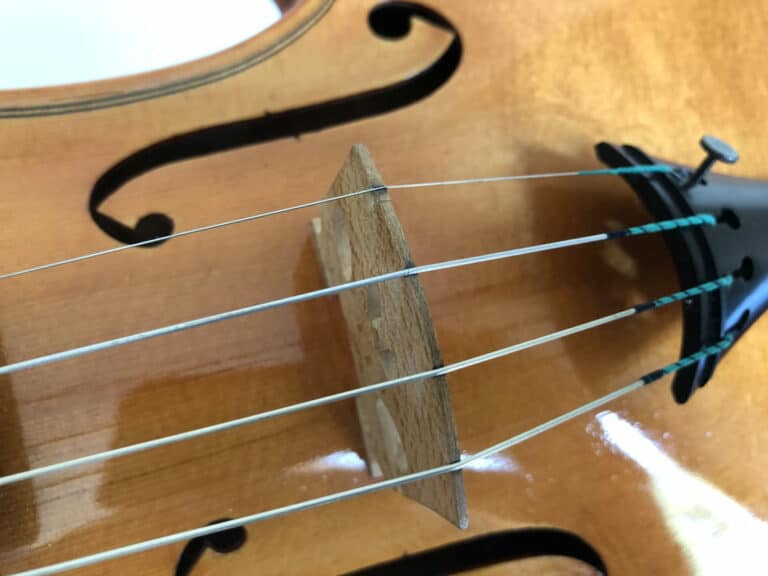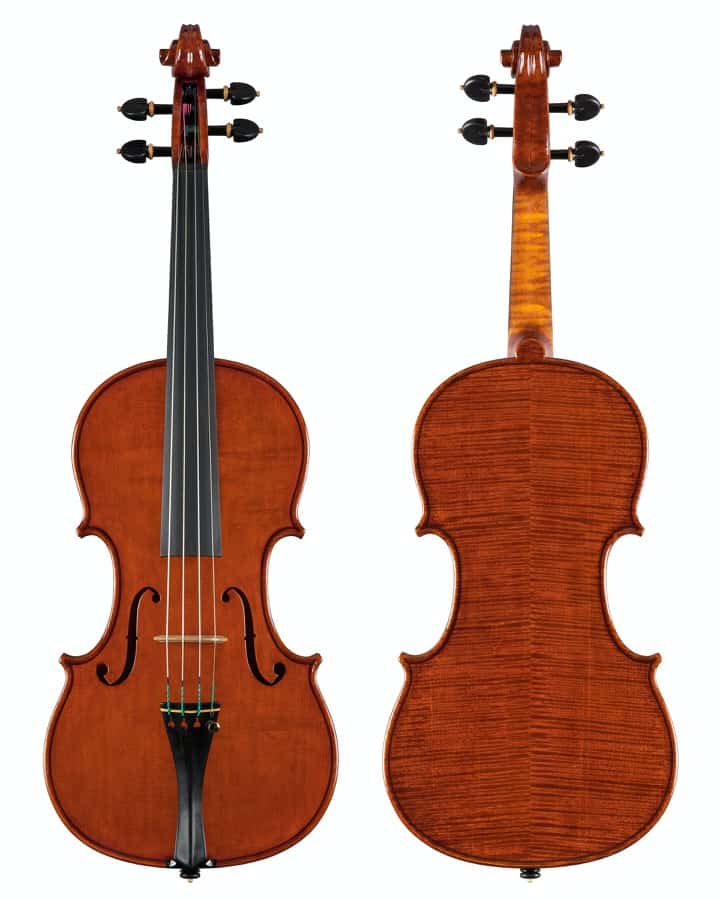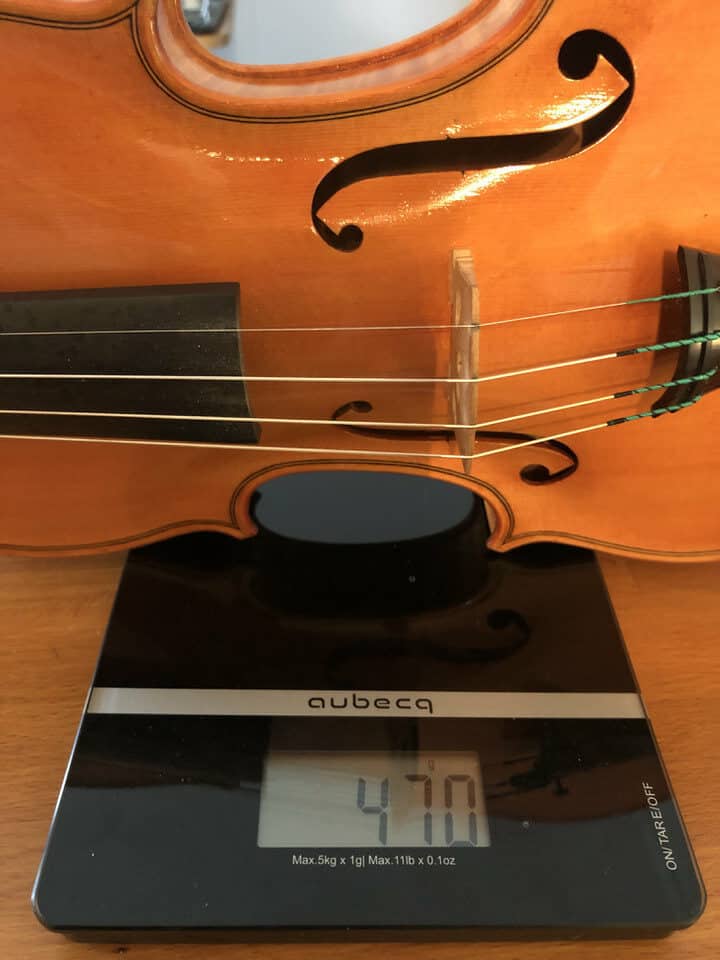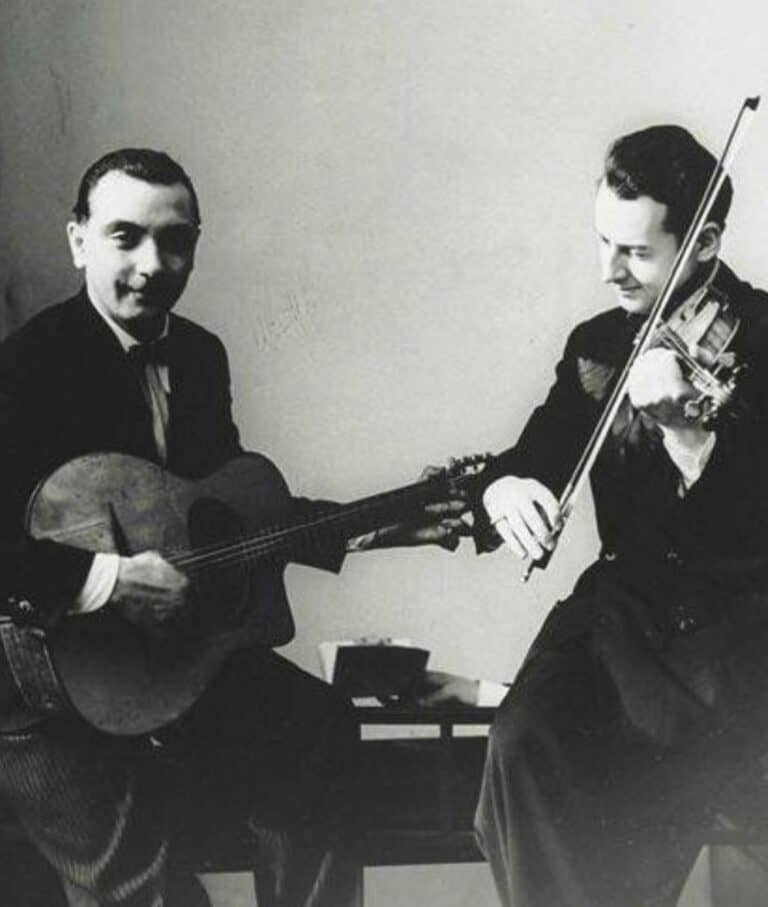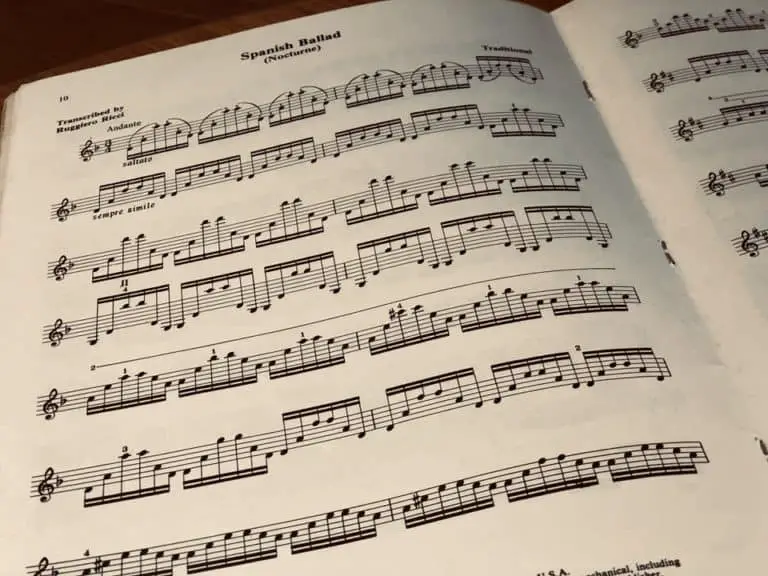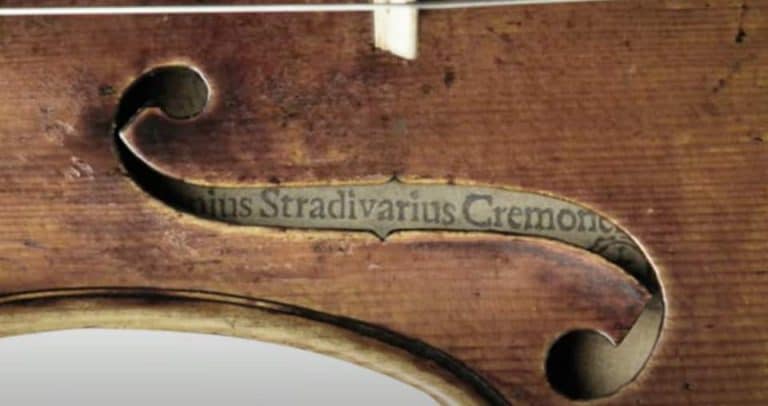How to Tune Your Violin Easily: a Simple Walkthrough
If you play the violin or the fiddle, you can’t always ask your teacher to tune your instrument. But do not feel intimidated: it is not difficult after all. Neither the mechanical part of it nor the musical one is out of reach if you follow the following way of doing. From sitting with the help of a tuner to standing while playing perfect fifth and turning the pegs.
To tune your violin, sit down and use a tuner, electronic, or on your phone. Go from below the note. Start with the A string, then D, G and finish with the E with a fine-tuner. Then play two strings at the same time and listen to the interval: a fifth. Next time, play the fifth with the bow while turning the pegs, all the strings in the same order. Then check the tuning with the tuner. Little by little, you will be able to tune your instrument without a tuner.
There is one and only tool to tune your violin: your ear. In the beginning, this seems overwhelming. But you will slowly learn to educate your ear and trust yourself. Your teacher will help you to tune your violin, but you can use what follows to train your ear by yourself and tune your instrument without any help, whether your teacher or a device.
What note A to choose?
A is the note that is most commonly used to tune most instruments. Only some wind instruments use another note, such as Bb. But as a general rule, orchestras and violins use the A note. But there isn’t such thing as an A note; there are several As.
The most used note is A 440 Hz.
Whether you tune your violin to a diapason, a piano, or an app, you adjust your string to a reference pitch or note. You need to make sure that the A you get is the one you want.
Historically, the A has gone up regularly. In the 18th century, the A was closer to 436 Hz, which is almost half a step compared to today’s A, comparatively an Ab. In a never-ending pursuit of brilliance and volume, musicians always play a bit higher. That is why orchestras of the 19th played higher, until today, reaching 440 Hz.
Some baroque musicians today like to play like musicians in that era and choose to go back to 436 Hz A.
My Russian Mentor has a 442 Hz diapason and told me that he used to play up to 444 Hz in Russia. More volume, more brilliance…
So, between the 18th and 20th-century Russian virtuosi, there is a whole step of difference. It is important to be aware of that. But let’s stick to a more commonly accepted 440 Hz A.
With an app on iPhone or Android and learn how to tune your instrument.
Our smartphones have replaced many devices now. It wouldn’t even occur to many young players to buy a diapason when they have their iPhone or Android phone with them.
The advantage of an app is to give you all the notes (strings) you need, not only A. It is easier because you will have G, D, A, and E. You will have a visual representation of the pitch of the note that will definitively help you if your ear is not ready yet.
It is the way many beginners will do. Good violinists and/or professionals won’t use an app to tune their violin or fiddle, I will explain why.
All right, let’s say we use an app to tune up our instrument. I would recommend to:
- Setup the app and choose the A you want: by default, it is set to 440 Hz;
- Start with the A string because it is with this string that you will start when or if you tune your violin without an app. Do not just look at the app, but try to educate your ear in the meantime.
- Now tune the D string, first by looking at the needle; then, forget the visual representation of the sound, and play the D string together with the A string. Listen to that pure 5th. Hearing that sound is crucial to develop your ear and be able to tune the violin by yourself one day.
- Now, tune the G string, by looking at your app. Again, close your eyes and listen to the G and D string at the same time. That 5th has a special sound that you will be able to recognize without any help eventually.
- Finish with the E string. Use the small tuner for that, as the E string has so much tension that it is particularly difficult to tune with the peg. If, as it occurs often, the tuner is at its maximum, unscrew it completely, wind up the string with the peg, a bit low, and adjust the tuning up with the fine tuner. Lastly, play the A and E strings together to familiarize yourself with the sound of that 5th.
If you tune your violin like that, you will have a violin well-tuned, but more importantly, you will start to follow the regular process of tuning a violin and develop your ear. You will eventually be tuning up your fiddle without an app in no time.
With a small tuner
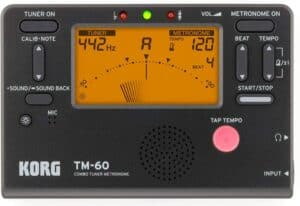
Small tuners are practical for musicians who do not want to use a smartphone for everything or do not have one.
It is basically a small device with a needle, which apps are a representation of. They need to have a small battery and a needle. You tune your instrument with such a tuner the same way as with an app (see above). Always use the needle to tune your string AND to train your ear. Day after day, you will recognize the sound of a perfect 5th, and you will see that tuning an instrument “manually” with your ear will eventually be quicker and more accurate than with an electronic device.
This one from Korg on Amazon is surprisingly cheap considering that it is made by a good brand and has a good set of features. It gives you the ability to use the metronome at the same time you check out the note you play which can be helpful. You can set up your A, and on the picture, it is 442 Hz.
There is an input: if you plug your electric violin, you will be able to tune it even in the noisiest environments of a jazz or rock concert.
With a tuner that clamps
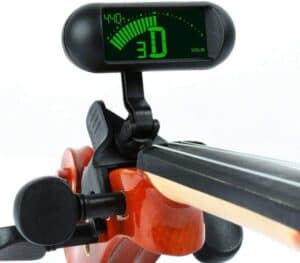
For a beginner, a good alternative solution is the use of a clip-on tuner. You will always have it in sight. And, as it is chromatic, it can help a beginner not only to tune an instrument but also to check notes in the absence of a teacher. It is a way to train your ear, and not a substitute for your ear, of course! At a response time inferior to 20ms, it allows you to play without being hindered by the device. The LCD is backlit: you can use it in the dark.
It didn’t exist when I began to play the violin, otherwise, I would have used one. The young violinists I know are pretty happy with that tuner.
With a piano or keyboard or small diapason or tuning fork
If you have a piano or play with a pianist, you can easily tune your instrument with it. It is essential to check the piano, even if you have a tuner, because what if the piano is a bit lower or higher pitch than the tuner? So the piano will give you an A: you will be able to tune your violin yourself using fifth, or carefully playing the corresponding G, D, A, and E on the piano.
A small diapason is a usual way to get an A when you are a professional player. It is light, cheap, requires no battery. I still have the diapason my parents bought me when I was six… You can put the diapason on the wood of the violin to hear it louder. But you need to be able to hear fifth to tune a violin this way.
Tune your violin by ear: finally, hear those 5ths
The violin is an instrument with a particular tuning: strings are separated by a perfect fifth. It is important, as I have mentioned above, to hear the fifth eventually. It will take some time, a couple of months, but you will eventually hear that interval. It is crucial.
So, look at the tuner, check the pitch of the note, yes, but then close your eyes and concentrate on the sound. Forget your eyes and your tuner:
- check the needle of the tuner;
- without looking at the tuner, listen, try and memorize the sound of the two strings played at once;
- later, when you feel confident, tune the string with the interval trusting your ear, and check the result with the tuner.
You will be able to tune your violin without any device in no time.
Tune your violin using harmonics like the best professionals
Now, we are talking about the advanced way of tuning a string instrument.
Best violinists do not only tune their instrument using fifth, they also use harmonics higher in the instrument. It has several advantages:
- it gives a double-check for a well-tuned violin;
- with a higher pitch, the harmonics have a tighter frequency: the interval will be narrower and the two string will result even more in tune;
- the stoped notes are higher on the fingerboard: if the fifth is in tune but the harmonics not so much, you will be able to spread out the difference of pitch slightly to have a violin in tune both in the low and high position;
- lately, you will detect false strings. That is to say, worn-out strings stretched differently and not uniformly. Such strings can have a good fifth with open strings (on the nut) but out of tune fifth up on the fingerboard. Whatever you do, your violin will be out of tune; the only remedy is to change your strings.
To tune your violin using harmonics, you can use:
- the harmonics of the main notes up an octave;
- the harmonics
Body position: how to hold your violin when tuning it
Beginners should tune their violin sitting on a chair
When you start off, the easier position is to sit down and hold the violin on your lap. Then you tune your violin by plucking the string with your left thumb, as if you were doing a pizzicato, and adjusting the string with your right hand at the same time. You won’t risk dropping your violin doing so. So this is the less risky way, albeit a slow way. But you won’t have to turn the peg and play with the bow at the same time.
Remember that, for the peg to hold its position and tension, you always need to finish off when screwing the peg, that is to say winding the string.: going from a lower note to a higher note. That way, you screw the peg into the pegbox, even so lightly, and it will stick.
If you start with a higher note and unscrew the peg to finish on the lower desired note, the beg won’t hold and your violin will be out of tune soon enough.
If you tune your instrument using pizzicati, the sound doesn’t resonate long enough. You only look at your tuner, app, or analog, and check for the frequency. But it will be particularly difficult to use only your ear because it isn’t convenient to play and hear fifth that way.
Intermediate violinists should tune their instruments while playing with the bow
So if you want to make progress, you will need to tune your fiddle while playing with the bow.
So, you need to be able to hold the violin without the left hand, only with the weight of the head on the chinrest, with the violin resting on the collarbone. This can be tricky at first and scare many beginners. But you will get used to it, all the more so as you can hold the violin a little bit with the scroll when turning the pegs. So playing without holding the violin is an essential prerequisite.
That is why you should have your peg in perfect condition, as I have detailed in that lengthy post on how to change strings on a violin. That way, your pegs are clean, can turn easily but hold their position strongly when needed. If you have set up your pegs the right way, as recommended, now you will get all the benefits from that extra time you took while installing your new set of strings. The fingers of your left hand will be able to slide easily between the pegs, and you will grab firmly the peg you want without a problem.
Now you can play the strings while turning the pegs, (from down to up, remember) either one at a time while checking your tuner or by playing fifth while trusting your ears.
Tuning the e string with a peg is really difficult and nobody does that standing. That is why even the die-hard classical players use a fine-tuner. It can be tricky to turn the tuner while playing because your hand will be twisted, won’t be able to support the violin this time, and the fine tuner can be hard. Once again, as I have detailed in the article above, having a fine tuner in perfect condition is crucial. So a tiny amount of grease from time to time is important. And before an important performance, check that the fine tuner is not completely screwed down: it will give you no chance to tune that string under pressure while playing and holding your violin. So unscrew your tuner two-thirds of the way: on third to unscrew (lower the note – less frequent), two-thirds to screw (raise a note – more frequent).
Troubleshooting: what can go wrong
The peg won’t hold when you tune your violin
What you need to do is, in order of importance:
- always tune your instrument from below: start from a lower note to a higher note. That way you screw the peg even slightly and the peg will stick more easily.
- If it is not enough, by holding your violin on your lap, screw the peg by applying more force.
- If the peg is still loose, what you have to do, is to loosen it completely, remove the chord, and clean it with Hill’s peg compound as I have described here.
The fine-tuner won’t turn
- If your tune doesn’t turn, maybe it is screwed all the way down: this is very common. We all tune up the E string and after a while, the fine-tuner has reached its maximum position. So, what we have to do is to unscrew it almost all the way, adjust the string accordingly with the peg, and fine-tune it with the tuner.
- if it is still hard to turn, loosen the string completely, put a small amount of grease on the tiny screw (don’t put some on the varnish!), and screw your tuner again: it should be easier to use! So there is a small part of maintenance in that small device…
- If it is still hard, now it is time to replace it. My favorite one is a Götz fine tuner; for that price on Amazon you shouldn’t lose too much time repairing your old one.
Types of strings: metal, synthetics, gut
Remember that the different materials out of which the strings are made have a big influence on how they can be tuned. Regardless of the sound:
- metal strings hold their tuning more steadily. They do not stretch much after their first installation. That is why they are commonly recommended for beginners. You won’t tune your violin too often with metal strings;
- Synthetic core strings are somehow in-between. When you first install them, they tend to stretch for a couple of days. You will have to tune your instrument a bit more often at the beginning. But they will eventually settle soon enough.
- Gut strings have a silky tone… they are lighter, and softer but are the most difficult to tune. They are alive; they stretch a long time after being installed. You will find it difficult to keep them in tune. That is why they are used mainly by professionals who know what they are doing and want that sound.
Temperature and hygrometry affect the tuning
Violins are made of wood and are sensitive to differences in temperature and hygrometry. Steel strings, not so much so. They hold their tuning quite well even if the temperature changes. Again, synthetic core strings are in-between: they suffer differences in the atmosphere. You will need to re-tune your violin more often: this is perfectly normal. Lastly, again, gut strings are really affected by hygrometry. If you change the climate, go to a humid country, and prepare to tune your violin a lot.
Type of music you play: you have to retune more often
Lastly, the physical forces applied to the strings when playing has an important effect on how long the instrument will hold its tuning. If you play hard, if you play three-note-chords or four-note-chords, the differences in tension might affect your tuning quickly unless you install your strings properly and lubricate the bridge and the nut, as I have explained in my article on how to install the strings.
Should I untune my violin after playing?
You should never untune your violin after playing. You should loosen your bow to protect its elasticity and camber, for sure. But the violin can accommodate the tension for a long period of time. And untuning between sessions it will do for harm than good. Just loosen the string a little bit if you think you won’t play your instrument for a very long time (a year or more), or if you’re going to take a long international flight where pressure, humidity, and temperature will vary a lot.

